Comprehensive Review of Advances in MRI Contrast Agents
VerifiedAdded on 2023/01/10
|15
|5120
|100
Report
AI Summary
This report provides a comprehensive overview of the advancements in MRI contrast agents, focusing on Gadolinium-based contrast agents (GBCAs) and their evolution since 1988. It explores the mode of action of GBCAs, including their impact on water proton relaxation and the role of Gadolinium (Gd3+) ions. The report discusses the characteristics and clinical applications of various GBCAs, including organ-specific agents and nanoparticles, emphasizing their role in enhancing the precision of MRI imaging. It highlights the development of new contrast agents, such as those based on nanoparticles, graphene oxides, and protein-based nanocages, and their potential to improve diagnostic capabilities. The report also covers the history, current trends, and future innovations in MRI contrast agents, offering insights into their impact on diagnostic medicine and the mapping of biochemical biomarkers for early disease detection and treatment evaluation. The report is contributed to Desklib, a platform providing AI-based study tools for students.
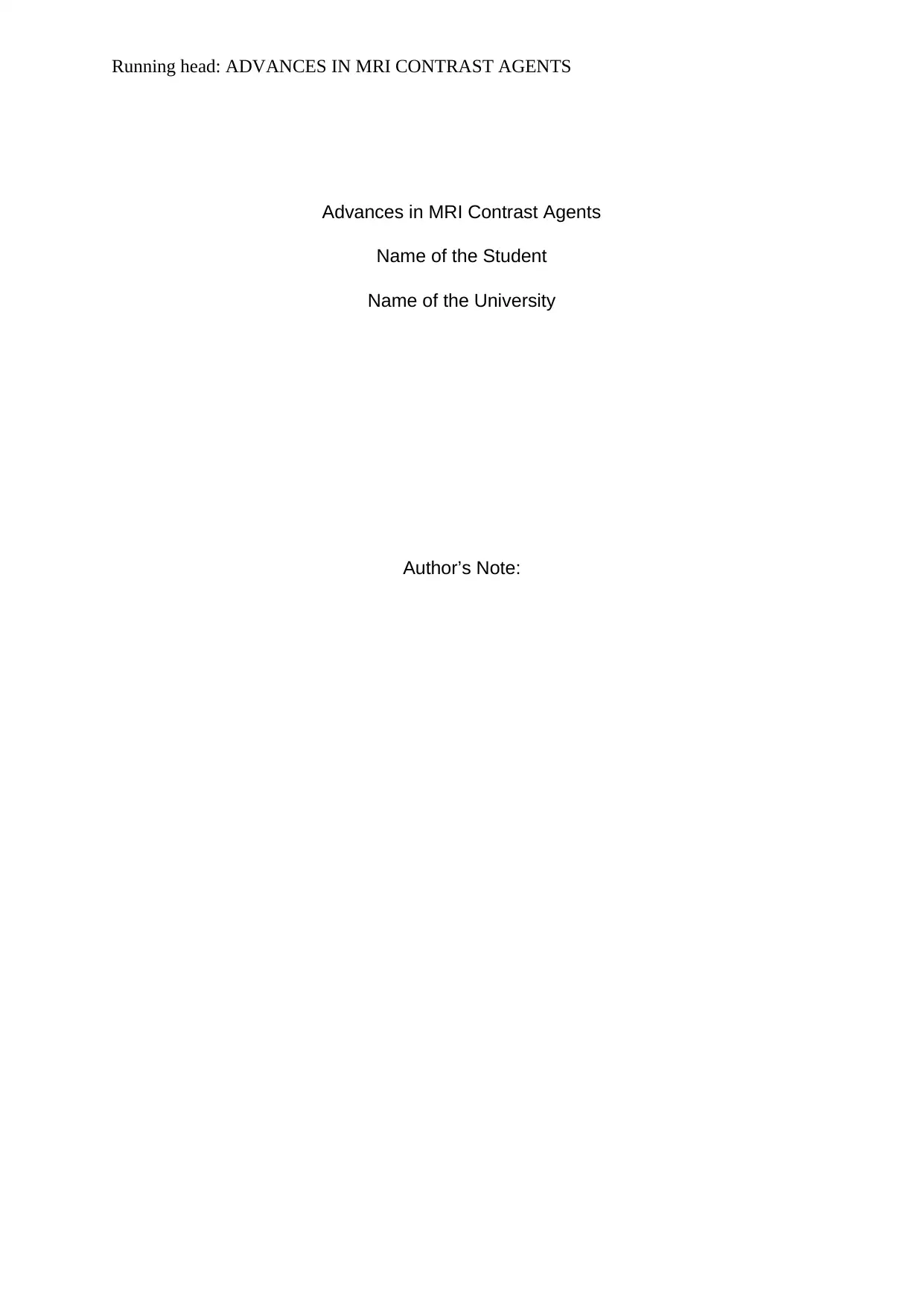
Running head: ADVANCES IN MRI CONTRAST AGENTS
Advances in MRI Contrast Agents
Name of the Student
Name of the University
Author’s Note:
Advances in MRI Contrast Agents
Name of the Student
Name of the University
Author’s Note:
Paraphrase This Document
Need a fresh take? Get an instant paraphrase of this document with our AI Paraphraser
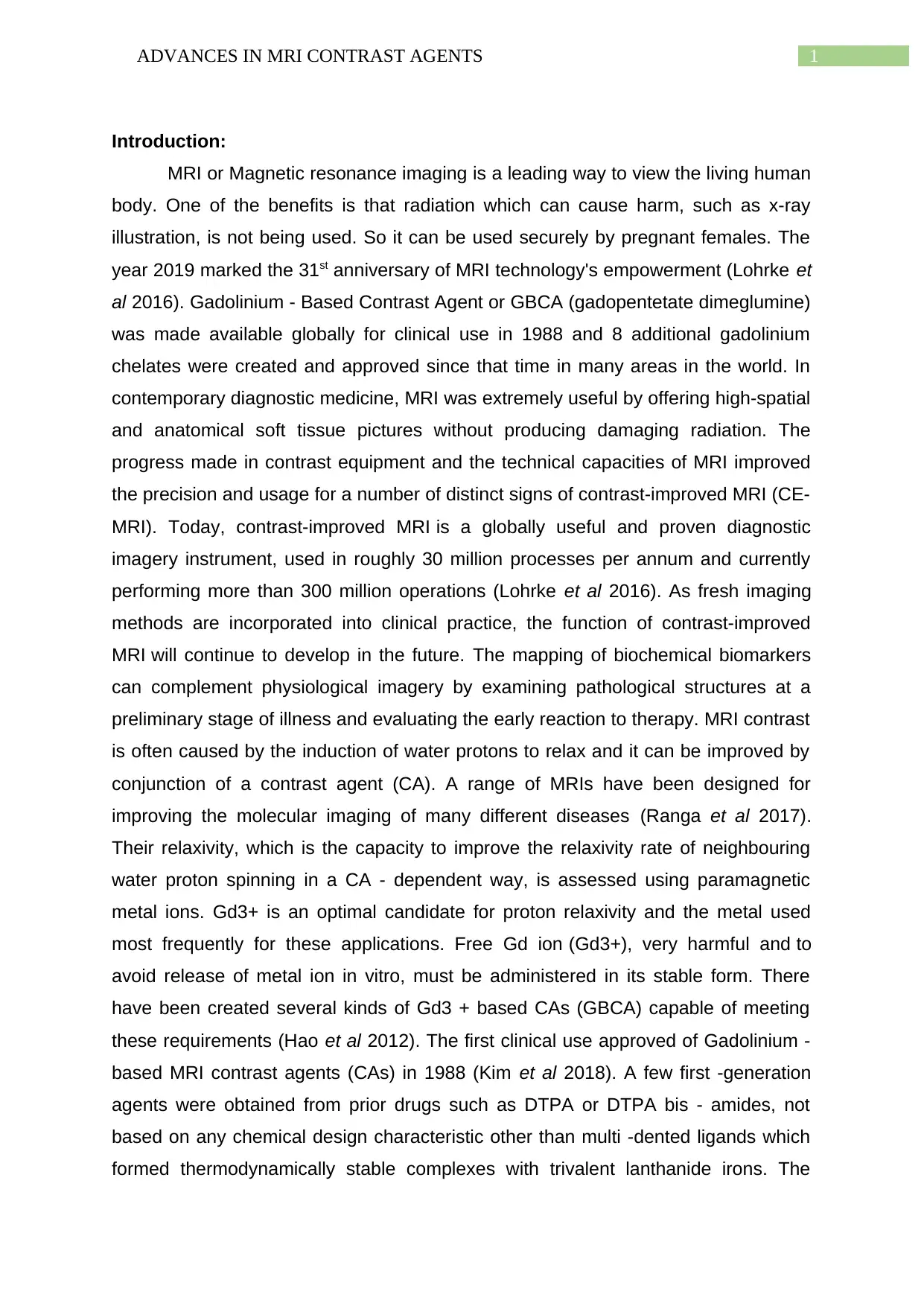
1ADVANCES IN MRI CONTRAST AGENTS
Introduction:
MRI or Magnetic resonance imaging is a leading way to view the living human
body. One of the benefits is that radiation which can cause harm, such as x-ray
illustration, is not being used. So it can be used securely by pregnant females. The
year 2019 marked the 31st anniversary of MRI technology's empowerment (Lohrke et
al 2016). Gadolinium - Based Contrast Agent or GBCA (gadopentetate dimeglumine)
was made available globally for clinical use in 1988 and 8 additional gadolinium
chelates were created and approved since that time in many areas in the world. In
contemporary diagnostic medicine, MRI was extremely useful by offering high-spatial
and anatomical soft tissue pictures without producing damaging radiation. The
progress made in contrast equipment and the technical capacities of MRI improved
the precision and usage for a number of distinct signs of contrast-improved MRI (CE-
MRI). Today, contrast-improved MRI is a globally useful and proven diagnostic
imagery instrument, used in roughly 30 million processes per annum and currently
performing more than 300 million operations (Lohrke et al 2016). As fresh imaging
methods are incorporated into clinical practice, the function of contrast-improved
MRI will continue to develop in the future. The mapping of biochemical biomarkers
can complement physiological imagery by examining pathological structures at a
preliminary stage of illness and evaluating the early reaction to therapy. MRI contrast
is often caused by the induction of water protons to relax and it can be improved by
conjunction of a contrast agent (CA). A range of MRIs have been designed for
improving the molecular imaging of many different diseases (Ranga et al 2017).
Their relaxivity, which is the capacity to improve the relaxivity rate of neighbouring
water proton spinning in a CA - dependent way, is assessed using paramagnetic
metal ions. Gd3+ is an optimal candidate for proton relaxivity and the metal used
most frequently for these applications. Free Gd ion (Gd3+), very harmful and to
avoid release of metal ion in vitro, must be administered in its stable form. There
have been created several kinds of Gd3 + based CAs (GBCA) capable of meeting
these requirements (Hao et al 2012). The first clinical use approved of Gadolinium -
based MRI contrast agents (CAs) in 1988 (Kim et al 2018). A few first -generation
agents were obtained from prior drugs such as DTPA or DTPA bis - amides, not
based on any chemical design characteristic other than multi -dented ligands which
formed thermodynamically stable complexes with trivalent lanthanide irons. The
Introduction:
MRI or Magnetic resonance imaging is a leading way to view the living human
body. One of the benefits is that radiation which can cause harm, such as x-ray
illustration, is not being used. So it can be used securely by pregnant females. The
year 2019 marked the 31st anniversary of MRI technology's empowerment (Lohrke et
al 2016). Gadolinium - Based Contrast Agent or GBCA (gadopentetate dimeglumine)
was made available globally for clinical use in 1988 and 8 additional gadolinium
chelates were created and approved since that time in many areas in the world. In
contemporary diagnostic medicine, MRI was extremely useful by offering high-spatial
and anatomical soft tissue pictures without producing damaging radiation. The
progress made in contrast equipment and the technical capacities of MRI improved
the precision and usage for a number of distinct signs of contrast-improved MRI (CE-
MRI). Today, contrast-improved MRI is a globally useful and proven diagnostic
imagery instrument, used in roughly 30 million processes per annum and currently
performing more than 300 million operations (Lohrke et al 2016). As fresh imaging
methods are incorporated into clinical practice, the function of contrast-improved
MRI will continue to develop in the future. The mapping of biochemical biomarkers
can complement physiological imagery by examining pathological structures at a
preliminary stage of illness and evaluating the early reaction to therapy. MRI contrast
is often caused by the induction of water protons to relax and it can be improved by
conjunction of a contrast agent (CA). A range of MRIs have been designed for
improving the molecular imaging of many different diseases (Ranga et al 2017).
Their relaxivity, which is the capacity to improve the relaxivity rate of neighbouring
water proton spinning in a CA - dependent way, is assessed using paramagnetic
metal ions. Gd3+ is an optimal candidate for proton relaxivity and the metal used
most frequently for these applications. Free Gd ion (Gd3+), very harmful and to
avoid release of metal ion in vitro, must be administered in its stable form. There
have been created several kinds of Gd3 + based CAs (GBCA) capable of meeting
these requirements (Hao et al 2012). The first clinical use approved of Gadolinium -
based MRI contrast agents (CAs) in 1988 (Kim et al 2018). A few first -generation
agents were obtained from prior drugs such as DTPA or DTPA bis - amides, not
based on any chemical design characteristic other than multi -dented ligands which
formed thermodynamically stable complexes with trivalent lanthanide irons. The
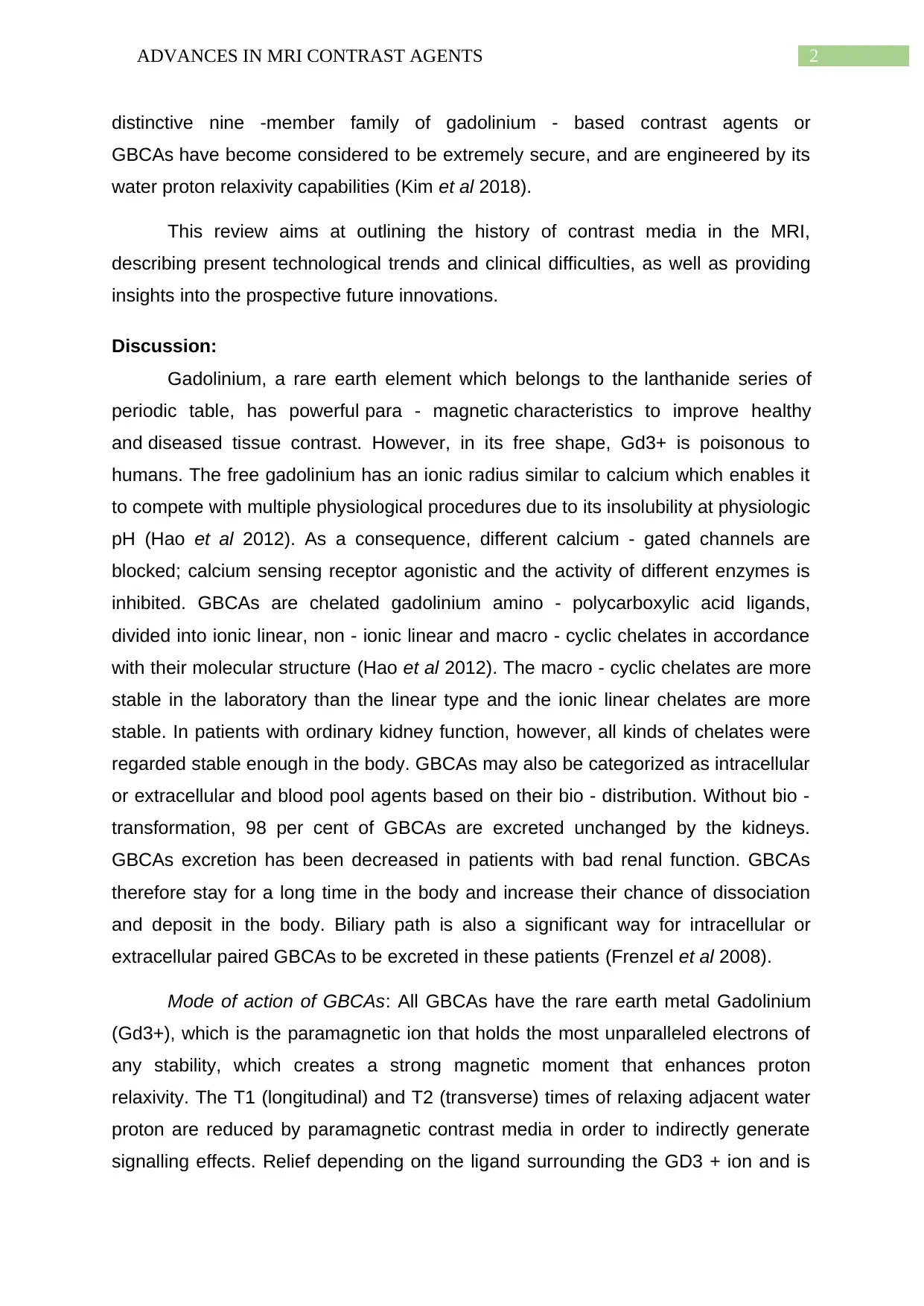
2ADVANCES IN MRI CONTRAST AGENTS
distinctive nine -member family of gadolinium - based contrast agents or
GBCAs have become considered to be extremely secure, and are engineered by its
water proton relaxivity capabilities (Kim et al 2018).
This review aims at outlining the history of contrast media in the MRI,
describing present technological trends and clinical difficulties, as well as providing
insights into the prospective future innovations.
Discussion:
Gadolinium, a rare earth element which belongs to the lanthanide series of
periodic table, has powerful para - magnetic characteristics to improve healthy
and diseased tissue contrast. However, in its free shape, Gd3+ is poisonous to
humans. The free gadolinium has an ionic radius similar to calcium which enables it
to compete with multiple physiological procedures due to its insolubility at physiologic
pH (Hao et al 2012). As a consequence, different calcium - gated channels are
blocked; calcium sensing receptor agonistic and the activity of different enzymes is
inhibited. GBCAs are chelated gadolinium amino - polycarboxylic acid ligands,
divided into ionic linear, non - ionic linear and macro - cyclic chelates in accordance
with their molecular structure (Hao et al 2012). The macro - cyclic chelates are more
stable in the laboratory than the linear type and the ionic linear chelates are more
stable. In patients with ordinary kidney function, however, all kinds of chelates were
regarded stable enough in the body. GBCAs may also be categorized as intracellular
or extracellular and blood pool agents based on their bio - distribution. Without bio -
transformation, 98 per cent of GBCAs are excreted unchanged by the kidneys.
GBCAs excretion has been decreased in patients with bad renal function. GBCAs
therefore stay for a long time in the body and increase their chance of dissociation
and deposit in the body. Biliary path is also a significant way for intracellular or
extracellular paired GBCAs to be excreted in these patients (Frenzel et al 2008).
Mode of action of GBCAs: All GBCAs have the rare earth metal Gadolinium
(Gd3+), which is the paramagnetic ion that holds the most unparalleled electrons of
any stability, which creates a strong magnetic moment that enhances proton
relaxivity. The T1 (longitudinal) and T2 (transverse) times of relaxing adjacent water
proton are reduced by paramagnetic contrast media in order to indirectly generate
signalling effects. Relief depending on the ligand surrounding the GD3 + ion and is
distinctive nine -member family of gadolinium - based contrast agents or
GBCAs have become considered to be extremely secure, and are engineered by its
water proton relaxivity capabilities (Kim et al 2018).
This review aims at outlining the history of contrast media in the MRI,
describing present technological trends and clinical difficulties, as well as providing
insights into the prospective future innovations.
Discussion:
Gadolinium, a rare earth element which belongs to the lanthanide series of
periodic table, has powerful para - magnetic characteristics to improve healthy
and diseased tissue contrast. However, in its free shape, Gd3+ is poisonous to
humans. The free gadolinium has an ionic radius similar to calcium which enables it
to compete with multiple physiological procedures due to its insolubility at physiologic
pH (Hao et al 2012). As a consequence, different calcium - gated channels are
blocked; calcium sensing receptor agonistic and the activity of different enzymes is
inhibited. GBCAs are chelated gadolinium amino - polycarboxylic acid ligands,
divided into ionic linear, non - ionic linear and macro - cyclic chelates in accordance
with their molecular structure (Hao et al 2012). The macro - cyclic chelates are more
stable in the laboratory than the linear type and the ionic linear chelates are more
stable. In patients with ordinary kidney function, however, all kinds of chelates were
regarded stable enough in the body. GBCAs may also be categorized as intracellular
or extracellular and blood pool agents based on their bio - distribution. Without bio -
transformation, 98 per cent of GBCAs are excreted unchanged by the kidneys.
GBCAs excretion has been decreased in patients with bad renal function. GBCAs
therefore stay for a long time in the body and increase their chance of dissociation
and deposit in the body. Biliary path is also a significant way for intracellular or
extracellular paired GBCAs to be excreted in these patients (Frenzel et al 2008).
Mode of action of GBCAs: All GBCAs have the rare earth metal Gadolinium
(Gd3+), which is the paramagnetic ion that holds the most unparalleled electrons of
any stability, which creates a strong magnetic moment that enhances proton
relaxivity. The T1 (longitudinal) and T2 (transverse) times of relaxing adjacent water
proton are reduced by paramagnetic contrast media in order to indirectly generate
signalling effects. Relief depending on the ligand surrounding the GD3 + ion and is
⊘ This is a preview!⊘
Do you want full access?
Subscribe today to unlock all pages.

Trusted by 1+ million students worldwide
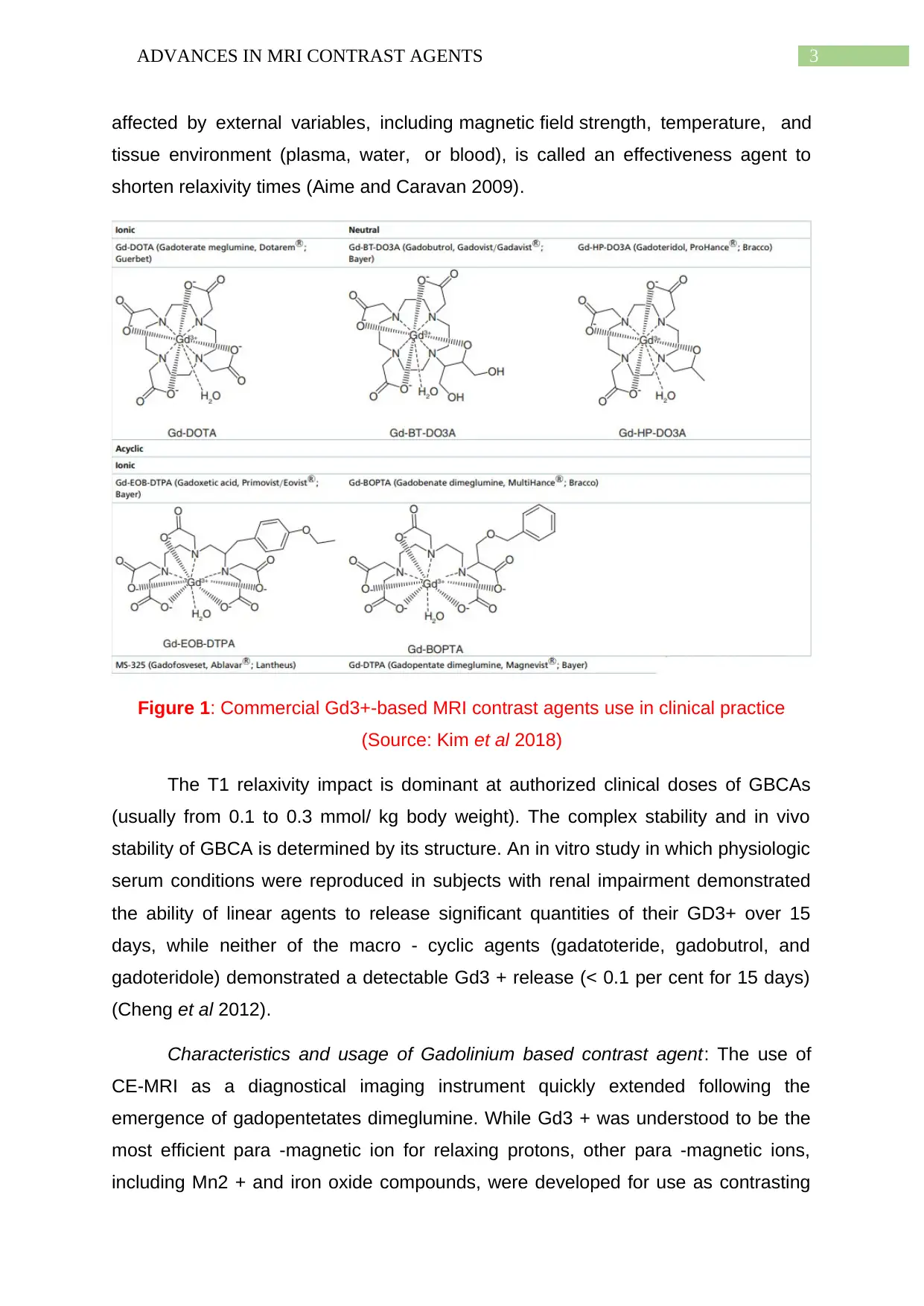
3ADVANCES IN MRI CONTRAST AGENTS
affected by external variables, including magnetic field strength, temperature, and
tissue environment (plasma, water, or blood), is called an effectiveness agent to
shorten relaxivity times (Aime and Caravan 2009).
Figure 1: Commercial Gd3+-based MRI contrast agents use in clinical practice
(Source: Kim et al 2018)
The T1 relaxivity impact is dominant at authorized clinical doses of GBCAs
(usually from 0.1 to 0.3 mmol/ kg body weight). The complex stability and in vivo
stability of GBCA is determined by its structure. An in vitro study in which physiologic
serum conditions were reproduced in subjects with renal impairment demonstrated
the ability of linear agents to release significant quantities of their GD3+ over 15
days, while neither of the macro - cyclic agents (gadatoteride, gadobutrol, and
gadoteridole) demonstrated a detectable Gd3 + release (< 0.1 per cent for 15 days)
(Cheng et al 2012).
Characteristics and usage of Gadolinium based contrast agent: The use of
CE-MRI as a diagnostical imaging instrument quickly extended following the
emergence of gadopentetates dimeglumine. While Gd3 + was understood to be the
most efficient para -magnetic ion for relaxing protons, other para -magnetic ions,
including Mn2 + and iron oxide compounds, were developed for use as contrasting
affected by external variables, including magnetic field strength, temperature, and
tissue environment (plasma, water, or blood), is called an effectiveness agent to
shorten relaxivity times (Aime and Caravan 2009).
Figure 1: Commercial Gd3+-based MRI contrast agents use in clinical practice
(Source: Kim et al 2018)
The T1 relaxivity impact is dominant at authorized clinical doses of GBCAs
(usually from 0.1 to 0.3 mmol/ kg body weight). The complex stability and in vivo
stability of GBCA is determined by its structure. An in vitro study in which physiologic
serum conditions were reproduced in subjects with renal impairment demonstrated
the ability of linear agents to release significant quantities of their GD3+ over 15
days, while neither of the macro - cyclic agents (gadatoteride, gadobutrol, and
gadoteridole) demonstrated a detectable Gd3 + release (< 0.1 per cent for 15 days)
(Cheng et al 2012).
Characteristics and usage of Gadolinium based contrast agent: The use of
CE-MRI as a diagnostical imaging instrument quickly extended following the
emergence of gadopentetates dimeglumine. While Gd3 + was understood to be the
most efficient para -magnetic ion for relaxing protons, other para -magnetic ions,
including Mn2 + and iron oxide compounds, were developed for use as contrasting
Paraphrase This Document
Need a fresh take? Get an instant paraphrase of this document with our AI Paraphraser
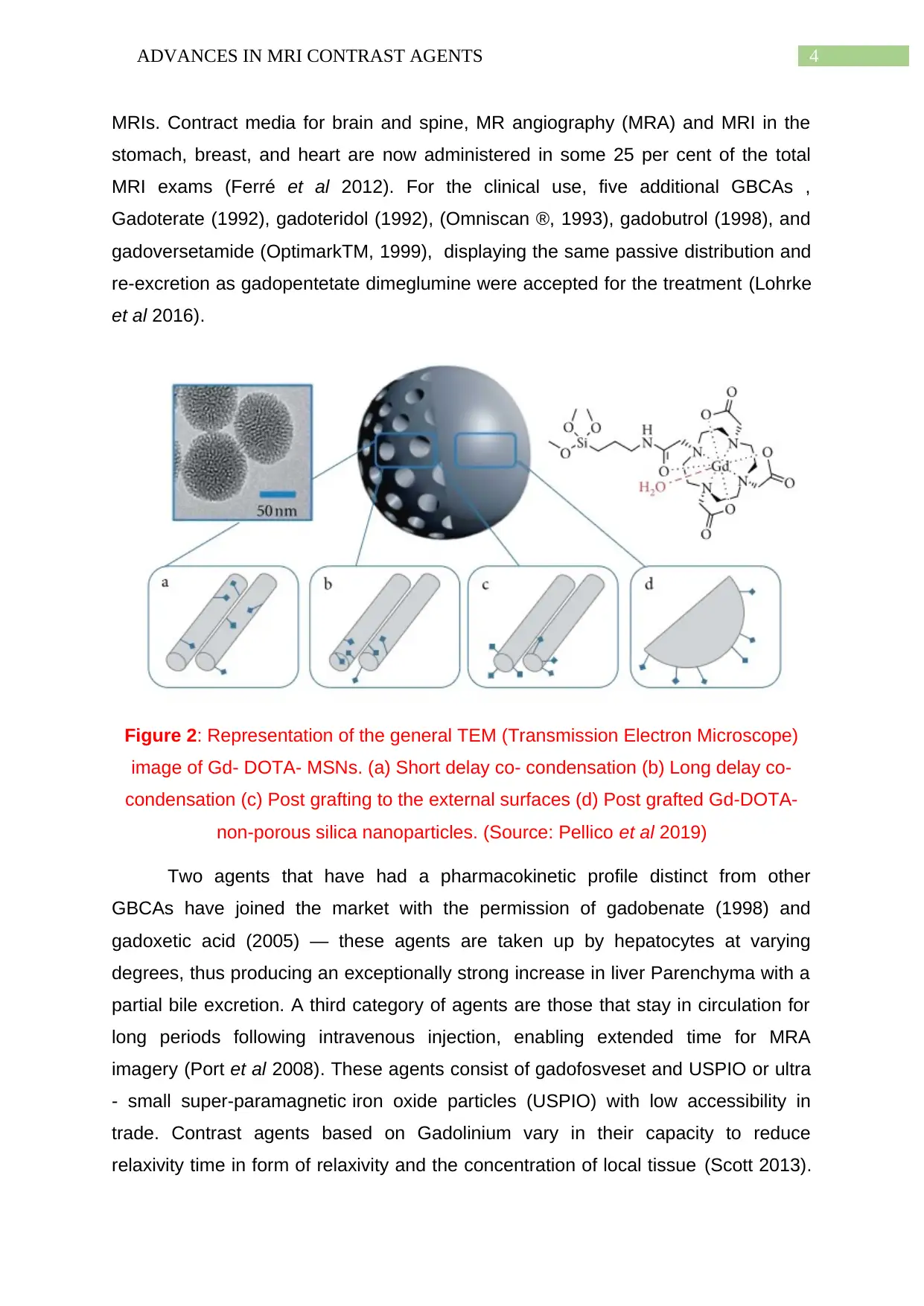
4ADVANCES IN MRI CONTRAST AGENTS
MRIs. Contract media for brain and spine, MR angiography (MRA) and MRI in the
stomach, breast, and heart are now administered in some 25 per cent of the total
MRI exams (Ferré et al 2012). For the clinical use, five additional GBCAs ,
Gadoterate (1992), gadoteridol (1992), (Omniscan ®, 1993), gadobutrol (1998), and
gadoversetamide (OptimarkTM, 1999), displaying the same passive distribution and
re-excretion as gadopentetate dimeglumine were accepted for the treatment (Lohrke
et al 2016).
Figure 2: Representation of the general TEM (Transmission Electron Microscope)
image of Gd- DOTA- MSNs. (a) Short delay co- condensation (b) Long delay co-
condensation (c) Post grafting to the external surfaces (d) Post grafted Gd-DOTA-
non-porous silica nanoparticles. (Source: Pellico et al 2019)
Two agents that have had a pharmacokinetic profile distinct from other
GBCAs have joined the market with the permission of gadobenate (1998) and
gadoxetic acid (2005) — these agents are taken up by hepatocytes at varying
degrees, thus producing an exceptionally strong increase in liver Parenchyma with a
partial bile excretion. A third category of agents are those that stay in circulation for
long periods following intravenous injection, enabling extended time for MRA
imagery (Port et al 2008). These agents consist of gadofosveset and USPIO or ultra
- small super-paramagnetic iron oxide particles (USPIO) with low accessibility in
trade. Contrast agents based on Gadolinium vary in their capacity to reduce
relaxivity time in form of relaxivity and the concentration of local tissue (Scott 2013).
MRIs. Contract media for brain and spine, MR angiography (MRA) and MRI in the
stomach, breast, and heart are now administered in some 25 per cent of the total
MRI exams (Ferré et al 2012). For the clinical use, five additional GBCAs ,
Gadoterate (1992), gadoteridol (1992), (Omniscan ®, 1993), gadobutrol (1998), and
gadoversetamide (OptimarkTM, 1999), displaying the same passive distribution and
re-excretion as gadopentetate dimeglumine were accepted for the treatment (Lohrke
et al 2016).
Figure 2: Representation of the general TEM (Transmission Electron Microscope)
image of Gd- DOTA- MSNs. (a) Short delay co- condensation (b) Long delay co-
condensation (c) Post grafting to the external surfaces (d) Post grafted Gd-DOTA-
non-porous silica nanoparticles. (Source: Pellico et al 2019)
Two agents that have had a pharmacokinetic profile distinct from other
GBCAs have joined the market with the permission of gadobenate (1998) and
gadoxetic acid (2005) — these agents are taken up by hepatocytes at varying
degrees, thus producing an exceptionally strong increase in liver Parenchyma with a
partial bile excretion. A third category of agents are those that stay in circulation for
long periods following intravenous injection, enabling extended time for MRA
imagery (Port et al 2008). These agents consist of gadofosveset and USPIO or ultra
- small super-paramagnetic iron oxide particles (USPIO) with low accessibility in
trade. Contrast agents based on Gadolinium vary in their capacity to reduce
relaxivity time in form of relaxivity and the concentration of local tissue (Scott 2013).
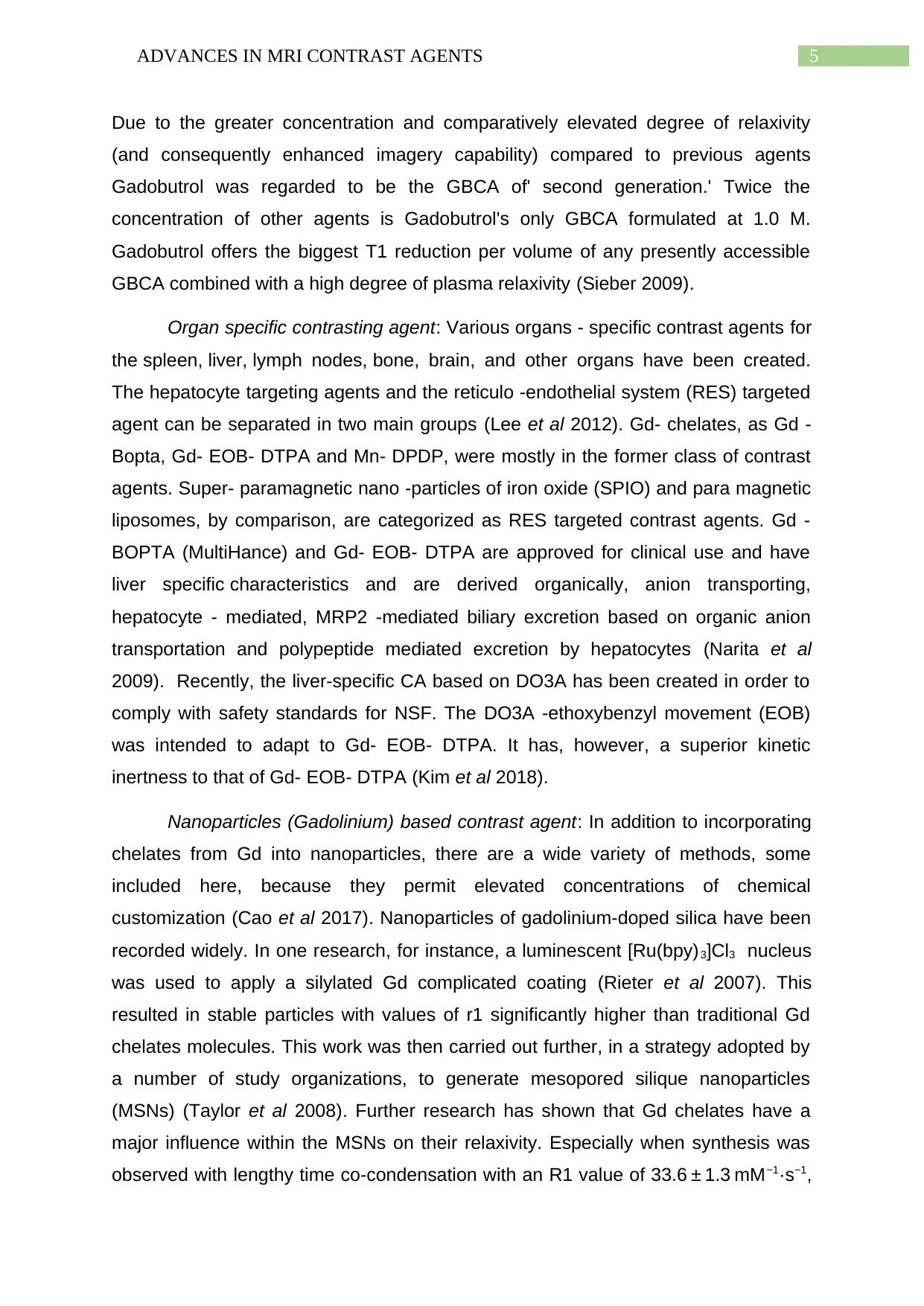
5ADVANCES IN MRI CONTRAST AGENTS
Due to the greater concentration and comparatively elevated degree of relaxivity
(and consequently enhanced imagery capability) compared to previous agents
Gadobutrol was regarded to be the GBCA of' second generation.' Twice the
concentration of other agents is Gadobutrol's only GBCA formulated at 1.0 M.
Gadobutrol offers the biggest T1 reduction per volume of any presently accessible
GBCA combined with a high degree of plasma relaxivity (Sieber 2009).
Organ specific contrasting agent: Various organs - specific contrast agents for
the spleen, liver, lymph nodes, bone, brain, and other organs have been created.
The hepatocyte targeting agents and the reticulo -endothelial system (RES) targeted
agent can be separated in two main groups (Lee et al 2012). Gd- chelates, as Gd -
Bopta, Gd- EOB- DTPA and Mn- DPDP, were mostly in the former class of contrast
agents. Super- paramagnetic nano -particles of iron oxide (SPIO) and para magnetic
liposomes, by comparison, are categorized as RES targeted contrast agents. Gd -
BOPTA (MultiHance) and Gd- EOB- DTPA are approved for clinical use and have
liver specific characteristics and are derived organically, anion transporting,
hepatocyte - mediated, MRP2 -mediated biliary excretion based on organic anion
transportation and polypeptide mediated excretion by hepatocytes (Narita et al
2009). Recently, the liver-specific CA based on DO3A has been created in order to
comply with safety standards for NSF. The DO3A -ethoxybenzyl movement (EOB)
was intended to adapt to Gd- EOB- DTPA. It has, however, a superior kinetic
inertness to that of Gd- EOB- DTPA (Kim et al 2018).
Nanoparticles (Gadolinium) based contrast agent: In addition to incorporating
chelates from Gd into nanoparticles, there are a wide variety of methods, some
included here, because they permit elevated concentrations of chemical
customization (Cao et al 2017). Nanoparticles of gadolinium-doped silica have been
recorded widely. In one research, for instance, a luminescent [Ru(bpy)3]Cl3 nucleus
was used to apply a silylated Gd complicated coating (Rieter et al 2007). This
resulted in stable particles with values of r1 significantly higher than traditional Gd
chelates molecules. This work was then carried out further, in a strategy adopted by
a number of study organizations, to generate mesopored silique nanoparticles
(MSNs) (Taylor et al 2008). Further research has shown that Gd chelates have a
major influence within the MSNs on their relaxivity. Especially when synthesis was
observed with lengthy time co-condensation with an R1 value of 33.6 ± 1.3 mM−1·s−1,
Due to the greater concentration and comparatively elevated degree of relaxivity
(and consequently enhanced imagery capability) compared to previous agents
Gadobutrol was regarded to be the GBCA of' second generation.' Twice the
concentration of other agents is Gadobutrol's only GBCA formulated at 1.0 M.
Gadobutrol offers the biggest T1 reduction per volume of any presently accessible
GBCA combined with a high degree of plasma relaxivity (Sieber 2009).
Organ specific contrasting agent: Various organs - specific contrast agents for
the spleen, liver, lymph nodes, bone, brain, and other organs have been created.
The hepatocyte targeting agents and the reticulo -endothelial system (RES) targeted
agent can be separated in two main groups (Lee et al 2012). Gd- chelates, as Gd -
Bopta, Gd- EOB- DTPA and Mn- DPDP, were mostly in the former class of contrast
agents. Super- paramagnetic nano -particles of iron oxide (SPIO) and para magnetic
liposomes, by comparison, are categorized as RES targeted contrast agents. Gd -
BOPTA (MultiHance) and Gd- EOB- DTPA are approved for clinical use and have
liver specific characteristics and are derived organically, anion transporting,
hepatocyte - mediated, MRP2 -mediated biliary excretion based on organic anion
transportation and polypeptide mediated excretion by hepatocytes (Narita et al
2009). Recently, the liver-specific CA based on DO3A has been created in order to
comply with safety standards for NSF. The DO3A -ethoxybenzyl movement (EOB)
was intended to adapt to Gd- EOB- DTPA. It has, however, a superior kinetic
inertness to that of Gd- EOB- DTPA (Kim et al 2018).
Nanoparticles (Gadolinium) based contrast agent: In addition to incorporating
chelates from Gd into nanoparticles, there are a wide variety of methods, some
included here, because they permit elevated concentrations of chemical
customization (Cao et al 2017). Nanoparticles of gadolinium-doped silica have been
recorded widely. In one research, for instance, a luminescent [Ru(bpy)3]Cl3 nucleus
was used to apply a silylated Gd complicated coating (Rieter et al 2007). This
resulted in stable particles with values of r1 significantly higher than traditional Gd
chelates molecules. This work was then carried out further, in a strategy adopted by
a number of study organizations, to generate mesopored silique nanoparticles
(MSNs) (Taylor et al 2008). Further research has shown that Gd chelates have a
major influence within the MSNs on their relaxivity. Especially when synthesis was
observed with lengthy time co-condensation with an R1 value of 33.6 ± 1.3 mM−1·s−1,
⊘ This is a preview!⊘
Do you want full access?
Subscribe today to unlock all pages.

Trusted by 1+ million students worldwide
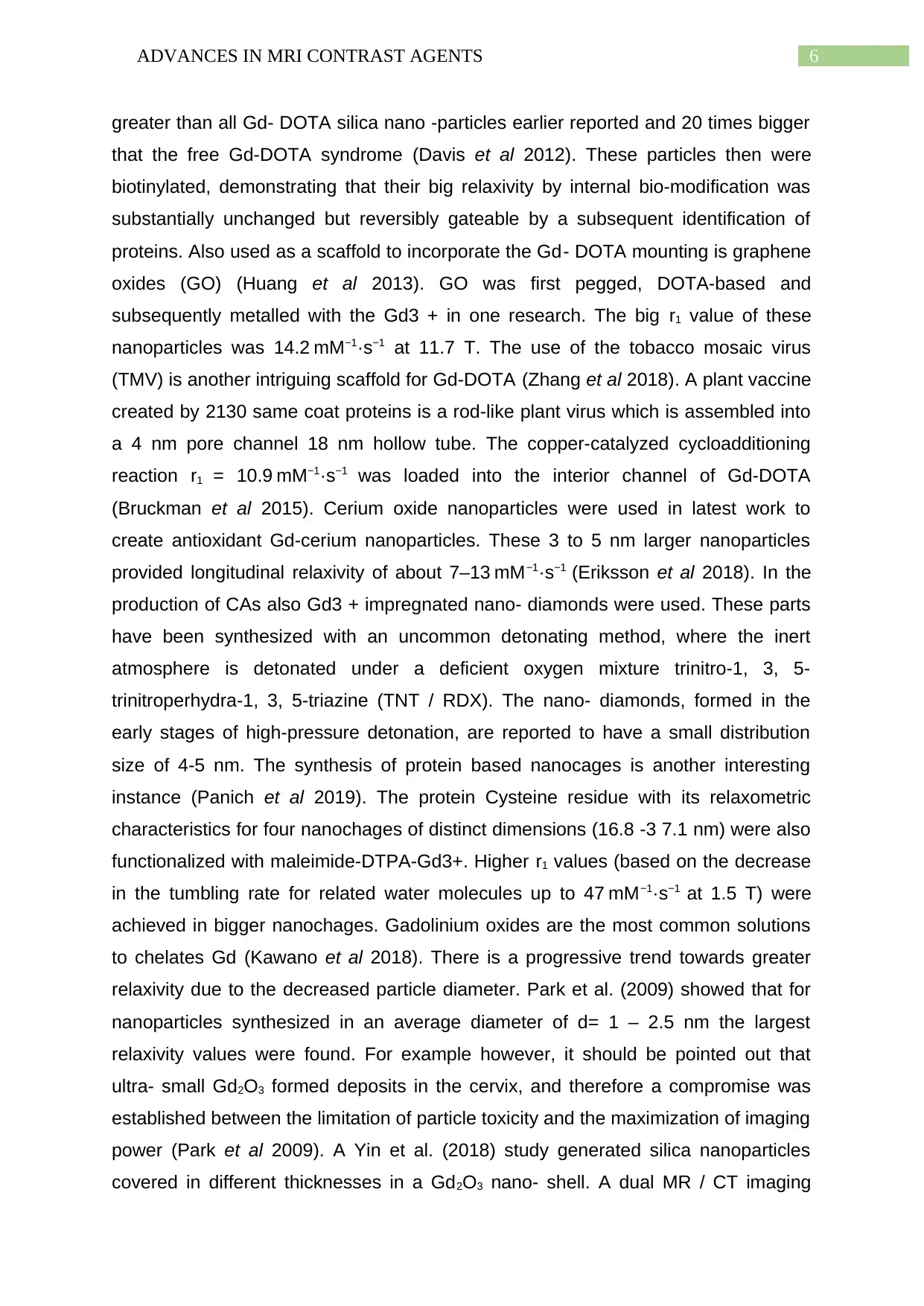
6ADVANCES IN MRI CONTRAST AGENTS
greater than all Gd- DOTA silica nano -particles earlier reported and 20 times bigger
that the free Gd-DOTA syndrome (Davis et al 2012). These particles then were
biotinylated, demonstrating that their big relaxivity by internal bio-modification was
substantially unchanged but reversibly gateable by a subsequent identification of
proteins. Also used as a scaffold to incorporate the Gd- DOTA mounting is graphene
oxides (GO) (Huang et al 2013). GO was first pegged, DOTA-based and
subsequently metalled with the Gd3 + in one research. The big r1 value of these
nanoparticles was 14.2 mM−1·s−1 at 11.7 T. The use of the tobacco mosaic virus
(TMV) is another intriguing scaffold for Gd-DOTA (Zhang et al 2018). A plant vaccine
created by 2130 same coat proteins is a rod-like plant virus which is assembled into
a 4 nm pore channel 18 nm hollow tube. The copper-catalyzed cycloadditioning
reaction r1 = 10.9 mM−1·s−1 was loaded into the interior channel of Gd-DOTA
(Bruckman et al 2015). Cerium oxide nanoparticles were used in latest work to
create antioxidant Gd-cerium nanoparticles. These 3 to 5 nm larger nanoparticles
provided longitudinal relaxivity of about 7–13 mM−1·s−1 (Eriksson et al 2018). In the
production of CAs also Gd3 + impregnated nano- diamonds were used. These parts
have been synthesized with an uncommon detonating method, where the inert
atmosphere is detonated under a deficient oxygen mixture trinitro-1, 3, 5-
trinitroperhydra-1, 3, 5-triazine (TNT / RDX). The nano- diamonds, formed in the
early stages of high-pressure detonation, are reported to have a small distribution
size of 4-5 nm. The synthesis of protein based nanocages is another interesting
instance (Panich et al 2019). The protein Cysteine residue with its relaxometric
characteristics for four nanochages of distinct dimensions (16.8 -3 7.1 nm) were also
functionalized with maleimide-DTPA-Gd3+. Higher r1 values (based on the decrease
in the tumbling rate for related water molecules up to 47 mM−1·s−1 at 1.5 T) were
achieved in bigger nanochages. Gadolinium oxides are the most common solutions
to chelates Gd (Kawano et al 2018). There is a progressive trend towards greater
relaxivity due to the decreased particle diameter. Park et al. (2009) showed that for
nanoparticles synthesized in an average diameter of d= 1 – 2.5 nm the largest
relaxivity values were found. For example however, it should be pointed out that
ultra- small Gd2O3 formed deposits in the cervix, and therefore a compromise was
established between the limitation of particle toxicity and the maximization of imaging
power (Park et al 2009). A Yin et al. (2018) study generated silica nanoparticles
covered in different thicknesses in a Gd2O3 nano- shell. A dual MR / CT imaging
greater than all Gd- DOTA silica nano -particles earlier reported and 20 times bigger
that the free Gd-DOTA syndrome (Davis et al 2012). These particles then were
biotinylated, demonstrating that their big relaxivity by internal bio-modification was
substantially unchanged but reversibly gateable by a subsequent identification of
proteins. Also used as a scaffold to incorporate the Gd- DOTA mounting is graphene
oxides (GO) (Huang et al 2013). GO was first pegged, DOTA-based and
subsequently metalled with the Gd3 + in one research. The big r1 value of these
nanoparticles was 14.2 mM−1·s−1 at 11.7 T. The use of the tobacco mosaic virus
(TMV) is another intriguing scaffold for Gd-DOTA (Zhang et al 2018). A plant vaccine
created by 2130 same coat proteins is a rod-like plant virus which is assembled into
a 4 nm pore channel 18 nm hollow tube. The copper-catalyzed cycloadditioning
reaction r1 = 10.9 mM−1·s−1 was loaded into the interior channel of Gd-DOTA
(Bruckman et al 2015). Cerium oxide nanoparticles were used in latest work to
create antioxidant Gd-cerium nanoparticles. These 3 to 5 nm larger nanoparticles
provided longitudinal relaxivity of about 7–13 mM−1·s−1 (Eriksson et al 2018). In the
production of CAs also Gd3 + impregnated nano- diamonds were used. These parts
have been synthesized with an uncommon detonating method, where the inert
atmosphere is detonated under a deficient oxygen mixture trinitro-1, 3, 5-
trinitroperhydra-1, 3, 5-triazine (TNT / RDX). The nano- diamonds, formed in the
early stages of high-pressure detonation, are reported to have a small distribution
size of 4-5 nm. The synthesis of protein based nanocages is another interesting
instance (Panich et al 2019). The protein Cysteine residue with its relaxometric
characteristics for four nanochages of distinct dimensions (16.8 -3 7.1 nm) were also
functionalized with maleimide-DTPA-Gd3+. Higher r1 values (based on the decrease
in the tumbling rate for related water molecules up to 47 mM−1·s−1 at 1.5 T) were
achieved in bigger nanochages. Gadolinium oxides are the most common solutions
to chelates Gd (Kawano et al 2018). There is a progressive trend towards greater
relaxivity due to the decreased particle diameter. Park et al. (2009) showed that for
nanoparticles synthesized in an average diameter of d= 1 – 2.5 nm the largest
relaxivity values were found. For example however, it should be pointed out that
ultra- small Gd2O3 formed deposits in the cervix, and therefore a compromise was
established between the limitation of particle toxicity and the maximization of imaging
power (Park et al 2009). A Yin et al. (2018) study generated silica nanoparticles
covered in different thicknesses in a Gd2O3 nano- shell. A dual MR / CT imaging
Paraphrase This Document
Need a fresh take? Get an instant paraphrase of this document with our AI Paraphraser
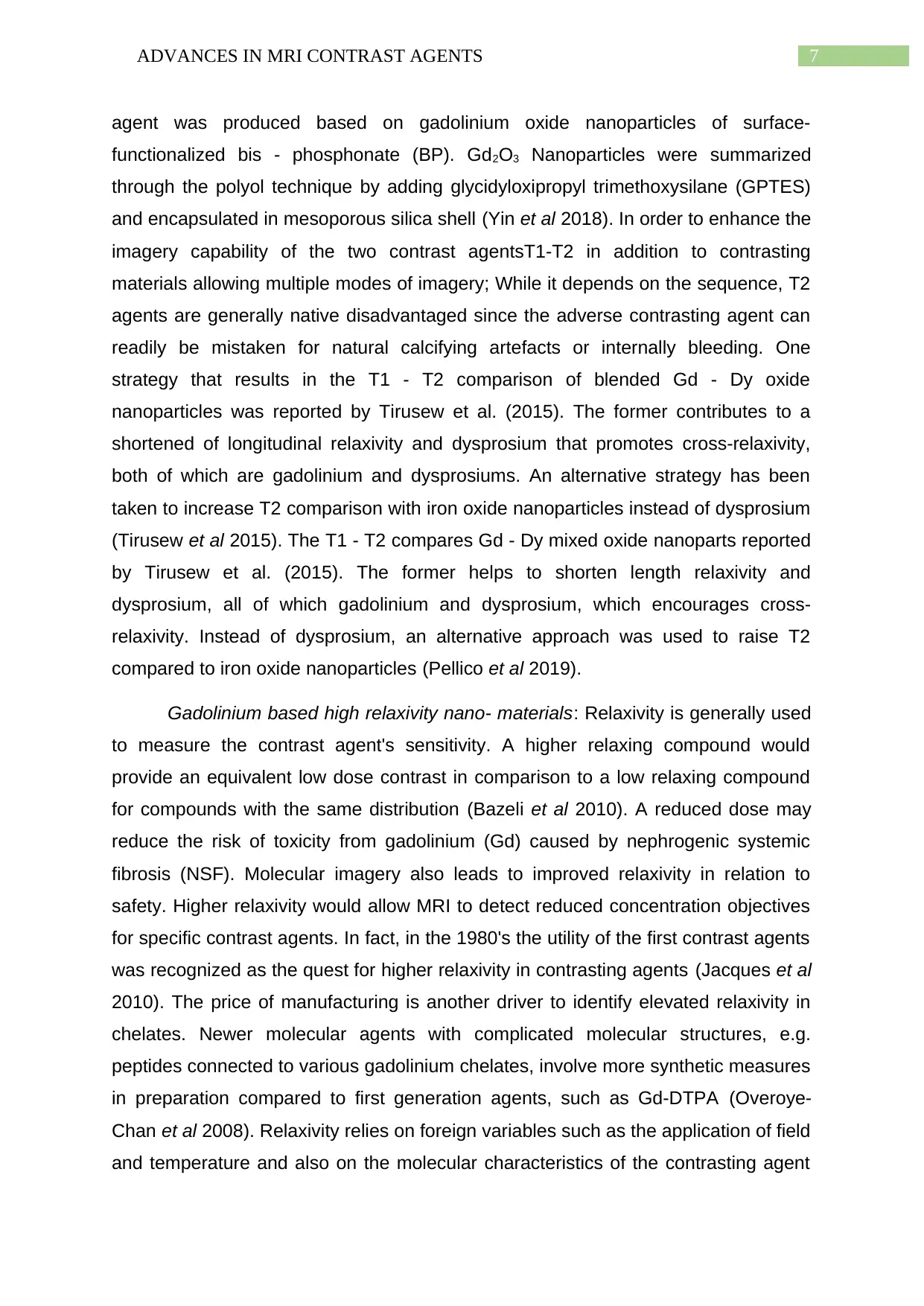
7ADVANCES IN MRI CONTRAST AGENTS
agent was produced based on gadolinium oxide nanoparticles of surface-
functionalized bis - phosphonate (BP). Gd2O3 Nanoparticles were summarized
through the polyol technique by adding glycidyloxipropyl trimethoxysilane (GPTES)
and encapsulated in mesoporous silica shell (Yin et al 2018). In order to enhance the
imagery capability of the two contrast agentsT1-T2 in addition to contrasting
materials allowing multiple modes of imagery; While it depends on the sequence, T2
agents are generally native disadvantaged since the adverse contrasting agent can
readily be mistaken for natural calcifying artefacts or internally bleeding. One
strategy that results in the T1 - T2 comparison of blended Gd - Dy oxide
nanoparticles was reported by Tirusew et al. (2015). The former contributes to a
shortened of longitudinal relaxivity and dysprosium that promotes cross-relaxivity,
both of which are gadolinium and dysprosiums. An alternative strategy has been
taken to increase T2 comparison with iron oxide nanoparticles instead of dysprosium
(Tirusew et al 2015). The T1 - T2 compares Gd - Dy mixed oxide nanoparts reported
by Tirusew et al. (2015). The former helps to shorten length relaxivity and
dysprosium, all of which gadolinium and dysprosium, which encourages cross-
relaxivity. Instead of dysprosium, an alternative approach was used to raise T2
compared to iron oxide nanoparticles (Pellico et al 2019).
Gadolinium based high relaxivity nano- materials: Relaxivity is generally used
to measure the contrast agent's sensitivity. A higher relaxing compound would
provide an equivalent low dose contrast in comparison to a low relaxing compound
for compounds with the same distribution (Bazeli et al 2010). A reduced dose may
reduce the risk of toxicity from gadolinium (Gd) caused by nephrogenic systemic
fibrosis (NSF). Molecular imagery also leads to improved relaxivity in relation to
safety. Higher relaxivity would allow MRI to detect reduced concentration objectives
for specific contrast agents. In fact, in the 1980's the utility of the first contrast agents
was recognized as the quest for higher relaxivity in contrasting agents (Jacques et al
2010). The price of manufacturing is another driver to identify elevated relaxivity in
chelates. Newer molecular agents with complicated molecular structures, e.g.
peptides connected to various gadolinium chelates, involve more synthetic measures
in preparation compared to first generation agents, such as Gd-DTPA (Overoye-
Chan et al 2008). Relaxivity relies on foreign variables such as the application of field
and temperature and also on the molecular characteristics of the contrasting agent
agent was produced based on gadolinium oxide nanoparticles of surface-
functionalized bis - phosphonate (BP). Gd2O3 Nanoparticles were summarized
through the polyol technique by adding glycidyloxipropyl trimethoxysilane (GPTES)
and encapsulated in mesoporous silica shell (Yin et al 2018). In order to enhance the
imagery capability of the two contrast agentsT1-T2 in addition to contrasting
materials allowing multiple modes of imagery; While it depends on the sequence, T2
agents are generally native disadvantaged since the adverse contrasting agent can
readily be mistaken for natural calcifying artefacts or internally bleeding. One
strategy that results in the T1 - T2 comparison of blended Gd - Dy oxide
nanoparticles was reported by Tirusew et al. (2015). The former contributes to a
shortened of longitudinal relaxivity and dysprosium that promotes cross-relaxivity,
both of which are gadolinium and dysprosiums. An alternative strategy has been
taken to increase T2 comparison with iron oxide nanoparticles instead of dysprosium
(Tirusew et al 2015). The T1 - T2 compares Gd - Dy mixed oxide nanoparts reported
by Tirusew et al. (2015). The former helps to shorten length relaxivity and
dysprosium, all of which gadolinium and dysprosium, which encourages cross-
relaxivity. Instead of dysprosium, an alternative approach was used to raise T2
compared to iron oxide nanoparticles (Pellico et al 2019).
Gadolinium based high relaxivity nano- materials: Relaxivity is generally used
to measure the contrast agent's sensitivity. A higher relaxing compound would
provide an equivalent low dose contrast in comparison to a low relaxing compound
for compounds with the same distribution (Bazeli et al 2010). A reduced dose may
reduce the risk of toxicity from gadolinium (Gd) caused by nephrogenic systemic
fibrosis (NSF). Molecular imagery also leads to improved relaxivity in relation to
safety. Higher relaxivity would allow MRI to detect reduced concentration objectives
for specific contrast agents. In fact, in the 1980's the utility of the first contrast agents
was recognized as the quest for higher relaxivity in contrasting agents (Jacques et al
2010). The price of manufacturing is another driver to identify elevated relaxivity in
chelates. Newer molecular agents with complicated molecular structures, e.g.
peptides connected to various gadolinium chelates, involve more synthetic measures
in preparation compared to first generation agents, such as Gd-DTPA (Overoye-
Chan et al 2008). Relaxivity relies on foreign variables such as the application of field
and temperature and also on the molecular characteristics of the contrasting agent
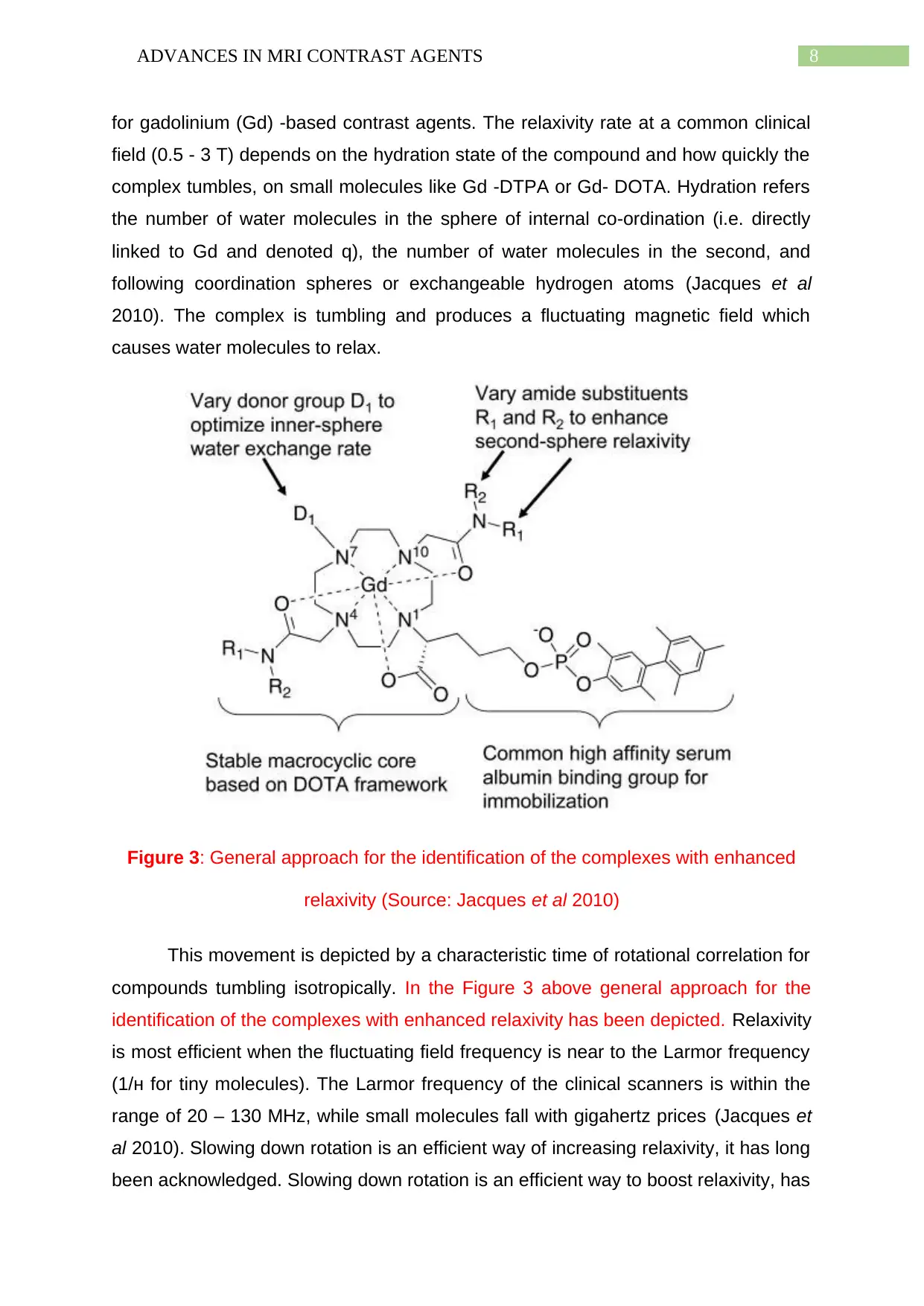
8ADVANCES IN MRI CONTRAST AGENTS
for gadolinium (Gd) -based contrast agents. The relaxivity rate at a common clinical
field (0.5 - 3 T) depends on the hydration state of the compound and how quickly the
complex tumbles, on small molecules like Gd -DTPA or Gd- DOTA. Hydration refers
the number of water molecules in the sphere of internal co-ordination (i.e. directly
linked to Gd and denoted q), the number of water molecules in the second, and
following coordination spheres or exchangeable hydrogen atoms (Jacques et al
2010). The complex is tumbling and produces a fluctuating magnetic field which
causes water molecules to relax.
Figure 3: General approach for the identification of the complexes with enhanced
relaxivity (Source: Jacques et al 2010)
This movement is depicted by a characteristic time of rotational correlation for
compounds tumbling isotropically. In the Figure 3 above general approach for the
identification of the complexes with enhanced relaxivity has been depicted. Relaxivity
is most efficient when the fluctuating field frequency is near to the Larmor frequency
(1/н for tiny molecules). The Larmor frequency of the clinical scanners is within the
range of 20 – 130 MHz, while small molecules fall with gigahertz prices (Jacques et
al 2010). Slowing down rotation is an efficient way of increasing relaxivity, it has long
been acknowledged. Slowing down rotation is an efficient way to boost relaxivity, has
for gadolinium (Gd) -based contrast agents. The relaxivity rate at a common clinical
field (0.5 - 3 T) depends on the hydration state of the compound and how quickly the
complex tumbles, on small molecules like Gd -DTPA or Gd- DOTA. Hydration refers
the number of water molecules in the sphere of internal co-ordination (i.e. directly
linked to Gd and denoted q), the number of water molecules in the second, and
following coordination spheres or exchangeable hydrogen atoms (Jacques et al
2010). The complex is tumbling and produces a fluctuating magnetic field which
causes water molecules to relax.
Figure 3: General approach for the identification of the complexes with enhanced
relaxivity (Source: Jacques et al 2010)
This movement is depicted by a characteristic time of rotational correlation for
compounds tumbling isotropically. In the Figure 3 above general approach for the
identification of the complexes with enhanced relaxivity has been depicted. Relaxivity
is most efficient when the fluctuating field frequency is near to the Larmor frequency
(1/н for tiny molecules). The Larmor frequency of the clinical scanners is within the
range of 20 – 130 MHz, while small molecules fall with gigahertz prices (Jacques et
al 2010). Slowing down rotation is an efficient way of increasing relaxivity, it has long
been acknowledged. Slowing down rotation is an efficient way to boost relaxivity, has
⊘ This is a preview!⊘
Do you want full access?
Subscribe today to unlock all pages.

Trusted by 1+ million students worldwide
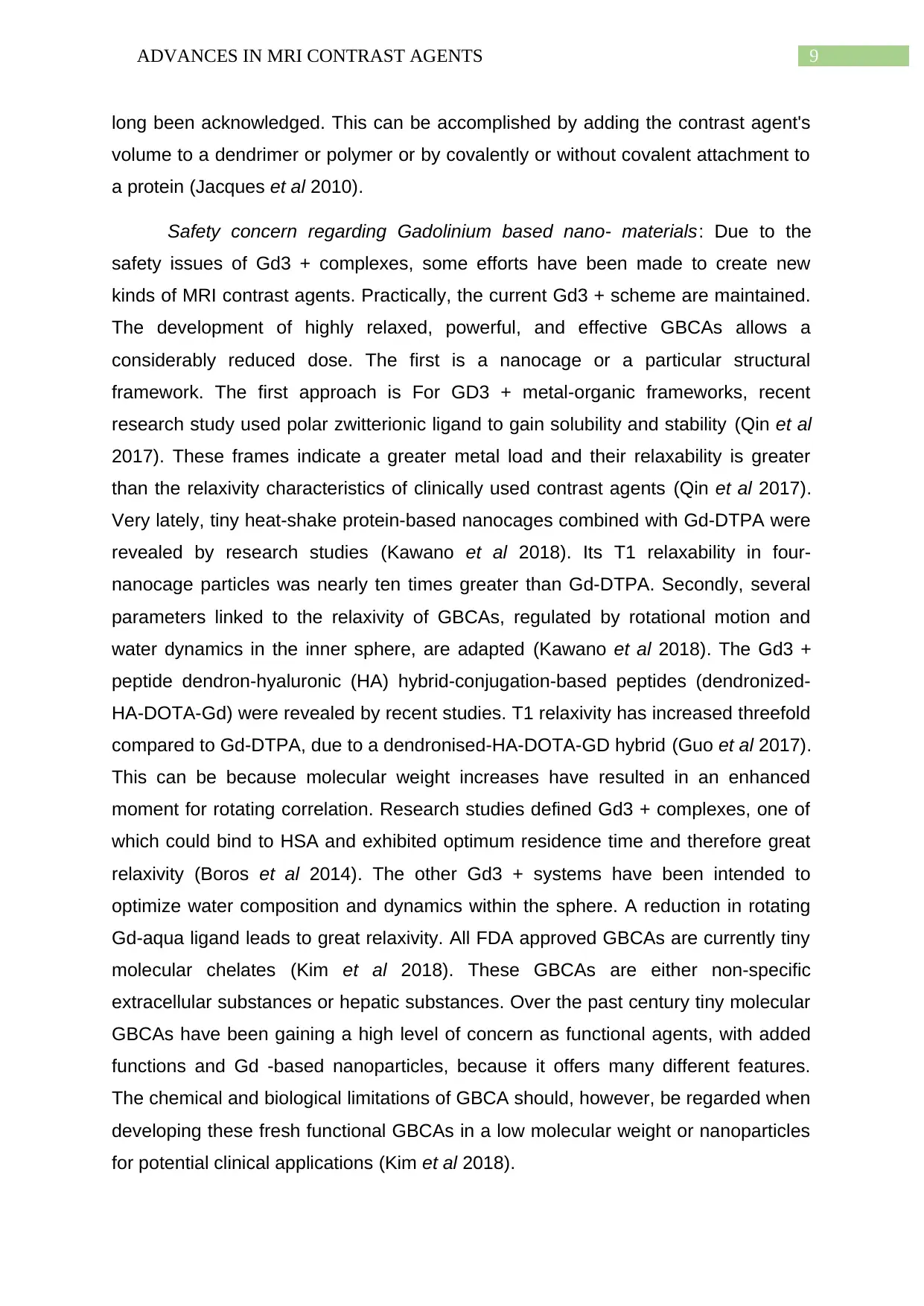
9ADVANCES IN MRI CONTRAST AGENTS
long been acknowledged. This can be accomplished by adding the contrast agent's
volume to a dendrimer or polymer or by covalently or without covalent attachment to
a protein (Jacques et al 2010).
Safety concern regarding Gadolinium based nano- materials: Due to the
safety issues of Gd3 + complexes, some efforts have been made to create new
kinds of MRI contrast agents. Practically, the current Gd3 + scheme are maintained.
The development of highly relaxed, powerful, and effective GBCAs allows a
considerably reduced dose. The first is a nanocage or a particular structural
framework. The first approach is For GD3 + metal-organic frameworks, recent
research study used polar zwitterionic ligand to gain solubility and stability (Qin et al
2017). These frames indicate a greater metal load and their relaxability is greater
than the relaxivity characteristics of clinically used contrast agents (Qin et al 2017).
Very lately, tiny heat-shake protein-based nanocages combined with Gd-DTPA were
revealed by research studies (Kawano et al 2018). Its T1 relaxability in four-
nanocage particles was nearly ten times greater than Gd-DTPA. Secondly, several
parameters linked to the relaxivity of GBCAs, regulated by rotational motion and
water dynamics in the inner sphere, are adapted (Kawano et al 2018). The Gd3 +
peptide dendron-hyaluronic (HA) hybrid-conjugation-based peptides (dendronized-
HA-DOTA-Gd) were revealed by recent studies. T1 relaxivity has increased threefold
compared to Gd-DTPA, due to a dendronised-HA-DOTA-GD hybrid (Guo et al 2017).
This can be because molecular weight increases have resulted in an enhanced
moment for rotating correlation. Research studies defined Gd3 + complexes, one of
which could bind to HSA and exhibited optimum residence time and therefore great
relaxivity (Boros et al 2014). The other Gd3 + systems have been intended to
optimize water composition and dynamics within the sphere. A reduction in rotating
Gd-aqua ligand leads to great relaxivity. All FDA approved GBCAs are currently tiny
molecular chelates (Kim et al 2018). These GBCAs are either non-specific
extracellular substances or hepatic substances. Over the past century tiny molecular
GBCAs have been gaining a high level of concern as functional agents, with added
functions and Gd -based nanoparticles, because it offers many different features.
The chemical and biological limitations of GBCA should, however, be regarded when
developing these fresh functional GBCAs in a low molecular weight or nanoparticles
for potential clinical applications (Kim et al 2018).
long been acknowledged. This can be accomplished by adding the contrast agent's
volume to a dendrimer or polymer or by covalently or without covalent attachment to
a protein (Jacques et al 2010).
Safety concern regarding Gadolinium based nano- materials: Due to the
safety issues of Gd3 + complexes, some efforts have been made to create new
kinds of MRI contrast agents. Practically, the current Gd3 + scheme are maintained.
The development of highly relaxed, powerful, and effective GBCAs allows a
considerably reduced dose. The first is a nanocage or a particular structural
framework. The first approach is For GD3 + metal-organic frameworks, recent
research study used polar zwitterionic ligand to gain solubility and stability (Qin et al
2017). These frames indicate a greater metal load and their relaxability is greater
than the relaxivity characteristics of clinically used contrast agents (Qin et al 2017).
Very lately, tiny heat-shake protein-based nanocages combined with Gd-DTPA were
revealed by research studies (Kawano et al 2018). Its T1 relaxability in four-
nanocage particles was nearly ten times greater than Gd-DTPA. Secondly, several
parameters linked to the relaxivity of GBCAs, regulated by rotational motion and
water dynamics in the inner sphere, are adapted (Kawano et al 2018). The Gd3 +
peptide dendron-hyaluronic (HA) hybrid-conjugation-based peptides (dendronized-
HA-DOTA-Gd) were revealed by recent studies. T1 relaxivity has increased threefold
compared to Gd-DTPA, due to a dendronised-HA-DOTA-GD hybrid (Guo et al 2017).
This can be because molecular weight increases have resulted in an enhanced
moment for rotating correlation. Research studies defined Gd3 + complexes, one of
which could bind to HSA and exhibited optimum residence time and therefore great
relaxivity (Boros et al 2014). The other Gd3 + systems have been intended to
optimize water composition and dynamics within the sphere. A reduction in rotating
Gd-aqua ligand leads to great relaxivity. All FDA approved GBCAs are currently tiny
molecular chelates (Kim et al 2018). These GBCAs are either non-specific
extracellular substances or hepatic substances. Over the past century tiny molecular
GBCAs have been gaining a high level of concern as functional agents, with added
functions and Gd -based nanoparticles, because it offers many different features.
The chemical and biological limitations of GBCA should, however, be regarded when
developing these fresh functional GBCAs in a low molecular weight or nanoparticles
for potential clinical applications (Kim et al 2018).
Paraphrase This Document
Need a fresh take? Get an instant paraphrase of this document with our AI Paraphraser
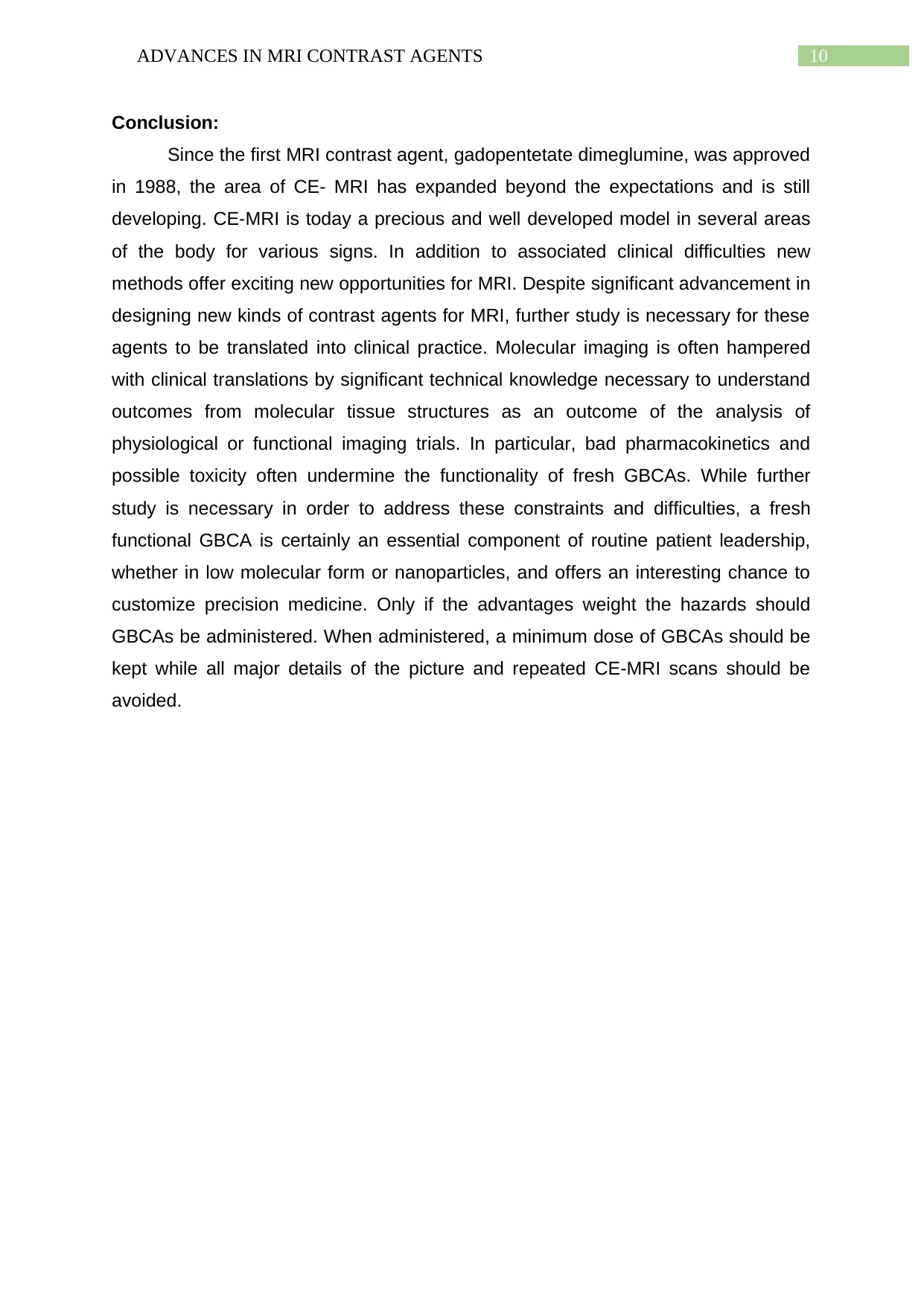
10ADVANCES IN MRI CONTRAST AGENTS
Conclusion:
Since the first MRI contrast agent, gadopentetate dimeglumine, was approved
in 1988, the area of CE- MRI has expanded beyond the expectations and is still
developing. CE-MRI is today a precious and well developed model in several areas
of the body for various signs. In addition to associated clinical difficulties new
methods offer exciting new opportunities for MRI. Despite significant advancement in
designing new kinds of contrast agents for MRI, further study is necessary for these
agents to be translated into clinical practice. Molecular imaging is often hampered
with clinical translations by significant technical knowledge necessary to understand
outcomes from molecular tissue structures as an outcome of the analysis of
physiological or functional imaging trials. In particular, bad pharmacokinetics and
possible toxicity often undermine the functionality of fresh GBCAs. While further
study is necessary in order to address these constraints and difficulties, a fresh
functional GBCA is certainly an essential component of routine patient leadership,
whether in low molecular form or nanoparticles, and offers an interesting chance to
customize precision medicine. Only if the advantages weight the hazards should
GBCAs be administered. When administered, a minimum dose of GBCAs should be
kept while all major details of the picture and repeated CE-MRI scans should be
avoided.
Conclusion:
Since the first MRI contrast agent, gadopentetate dimeglumine, was approved
in 1988, the area of CE- MRI has expanded beyond the expectations and is still
developing. CE-MRI is today a precious and well developed model in several areas
of the body for various signs. In addition to associated clinical difficulties new
methods offer exciting new opportunities for MRI. Despite significant advancement in
designing new kinds of contrast agents for MRI, further study is necessary for these
agents to be translated into clinical practice. Molecular imaging is often hampered
with clinical translations by significant technical knowledge necessary to understand
outcomes from molecular tissue structures as an outcome of the analysis of
physiological or functional imaging trials. In particular, bad pharmacokinetics and
possible toxicity often undermine the functionality of fresh GBCAs. While further
study is necessary in order to address these constraints and difficulties, a fresh
functional GBCA is certainly an essential component of routine patient leadership,
whether in low molecular form or nanoparticles, and offers an interesting chance to
customize precision medicine. Only if the advantages weight the hazards should
GBCAs be administered. When administered, a minimum dose of GBCAs should be
kept while all major details of the picture and repeated CE-MRI scans should be
avoided.
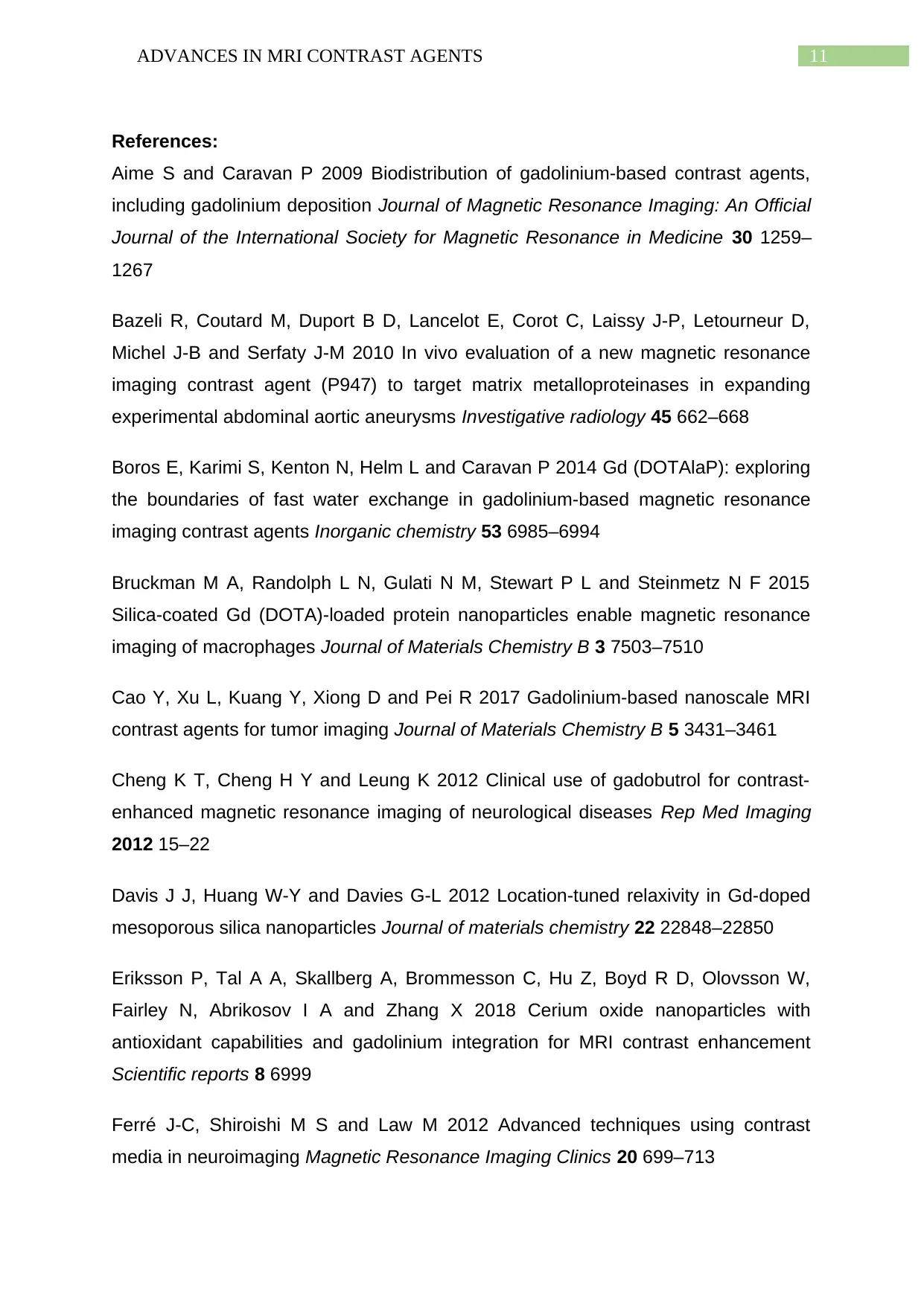
11ADVANCES IN MRI CONTRAST AGENTS
References:
Aime S and Caravan P 2009 Biodistribution of gadolinium-based contrast agents,
including gadolinium deposition Journal of Magnetic Resonance Imaging: An Official
Journal of the International Society for Magnetic Resonance in Medicine 30 1259–
1267
Bazeli R, Coutard M, Duport B D, Lancelot E, Corot C, Laissy J-P, Letourneur D,
Michel J-B and Serfaty J-M 2010 In vivo evaluation of a new magnetic resonance
imaging contrast agent (P947) to target matrix metalloproteinases in expanding
experimental abdominal aortic aneurysms Investigative radiology 45 662–668
Boros E, Karimi S, Kenton N, Helm L and Caravan P 2014 Gd (DOTAlaP): exploring
the boundaries of fast water exchange in gadolinium-based magnetic resonance
imaging contrast agents Inorganic chemistry 53 6985–6994
Bruckman M A, Randolph L N, Gulati N M, Stewart P L and Steinmetz N F 2015
Silica-coated Gd (DOTA)-loaded protein nanoparticles enable magnetic resonance
imaging of macrophages Journal of Materials Chemistry B 3 7503–7510
Cao Y, Xu L, Kuang Y, Xiong D and Pei R 2017 Gadolinium-based nanoscale MRI
contrast agents for tumor imaging Journal of Materials Chemistry B 5 3431–3461
Cheng K T, Cheng H Y and Leung K 2012 Clinical use of gadobutrol for contrast-
enhanced magnetic resonance imaging of neurological diseases Rep Med Imaging
2012 15–22
Davis J J, Huang W-Y and Davies G-L 2012 Location-tuned relaxivity in Gd-doped
mesoporous silica nanoparticles Journal of materials chemistry 22 22848–22850
Eriksson P, Tal A A, Skallberg A, Brommesson C, Hu Z, Boyd R D, Olovsson W,
Fairley N, Abrikosov I A and Zhang X 2018 Cerium oxide nanoparticles with
antioxidant capabilities and gadolinium integration for MRI contrast enhancement
Scientific reports 8 6999
Ferré J-C, Shiroishi M S and Law M 2012 Advanced techniques using contrast
media in neuroimaging Magnetic Resonance Imaging Clinics 20 699–713
References:
Aime S and Caravan P 2009 Biodistribution of gadolinium-based contrast agents,
including gadolinium deposition Journal of Magnetic Resonance Imaging: An Official
Journal of the International Society for Magnetic Resonance in Medicine 30 1259–
1267
Bazeli R, Coutard M, Duport B D, Lancelot E, Corot C, Laissy J-P, Letourneur D,
Michel J-B and Serfaty J-M 2010 In vivo evaluation of a new magnetic resonance
imaging contrast agent (P947) to target matrix metalloproteinases in expanding
experimental abdominal aortic aneurysms Investigative radiology 45 662–668
Boros E, Karimi S, Kenton N, Helm L and Caravan P 2014 Gd (DOTAlaP): exploring
the boundaries of fast water exchange in gadolinium-based magnetic resonance
imaging contrast agents Inorganic chemistry 53 6985–6994
Bruckman M A, Randolph L N, Gulati N M, Stewart P L and Steinmetz N F 2015
Silica-coated Gd (DOTA)-loaded protein nanoparticles enable magnetic resonance
imaging of macrophages Journal of Materials Chemistry B 3 7503–7510
Cao Y, Xu L, Kuang Y, Xiong D and Pei R 2017 Gadolinium-based nanoscale MRI
contrast agents for tumor imaging Journal of Materials Chemistry B 5 3431–3461
Cheng K T, Cheng H Y and Leung K 2012 Clinical use of gadobutrol for contrast-
enhanced magnetic resonance imaging of neurological diseases Rep Med Imaging
2012 15–22
Davis J J, Huang W-Y and Davies G-L 2012 Location-tuned relaxivity in Gd-doped
mesoporous silica nanoparticles Journal of materials chemistry 22 22848–22850
Eriksson P, Tal A A, Skallberg A, Brommesson C, Hu Z, Boyd R D, Olovsson W,
Fairley N, Abrikosov I A and Zhang X 2018 Cerium oxide nanoparticles with
antioxidant capabilities and gadolinium integration for MRI contrast enhancement
Scientific reports 8 6999
Ferré J-C, Shiroishi M S and Law M 2012 Advanced techniques using contrast
media in neuroimaging Magnetic Resonance Imaging Clinics 20 699–713
⊘ This is a preview!⊘
Do you want full access?
Subscribe today to unlock all pages.

Trusted by 1+ million students worldwide
1 out of 15
Your All-in-One AI-Powered Toolkit for Academic Success.
+13062052269
info@desklib.com
Available 24*7 on WhatsApp / Email
![[object Object]](/_next/static/media/star-bottom.7253800d.svg)
Unlock your academic potential
Copyright © 2020–2025 A2Z Services. All Rights Reserved. Developed and managed by ZUCOL.